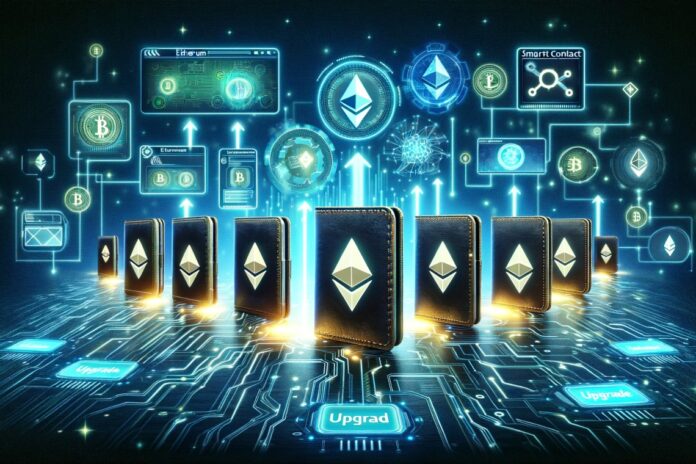One month after the Dencun update and after 4 years of hard work, Ethereum developers are planning the next evolutionary steps in the network’s smart contracts, setting the appointment for the “Pectra” update at the end of 2024 or beginning of 2025.
This latest one takes its name from the fusion of the small updates “Praga” and “Electra”, applied respectively at the execution and consensus level, and will introduce exclusive features within EVM wallets.
With Pectra, it will be possible to delegate functions to smart contracts directly from the cryptographic wallet, approve batch transactions, and pay gas with different ERC-20 tokens.
Let’s see all the details below.
Summary
Pectra Update: Ethereum developers improve wallet functionalities allowing delegation of functions to smart contracts
After about four years since his first appointment, Ethereum developers are about to set a final date for the completion of the “Pectra” update which will introduce changes to the code that will greatly improve the user experience.
Those working on the Ethereum network are about to include what was discussed in the EIP-3074 within the upcoming Pectra update, unlocking exclusive features such as the ability to delegate functions to smart contracts directly from the wallet.
In particular, the proposal, if accepted by the community, will allow batch transactions and payment of gas fees with different ERC-20 tokens, without having to refer to ether as the only gas token anymore.
It is also worth noting how EIP-3047 brings developers closer to the full implementation of the “account abstraction” function, which will allow them to recover their assets in case of loss of private keys through “social recovery” means.
This latest feature, which represents a milestone for the Ethereum ecosystem, will not be fully ready for Pectra because wallets, although they can delegate functions to smart contracts, cannot yet initiate transactions.
The improvements discussed in this Ethereum Improvement Proposal also bring some limitations in terms of security: computer experts have in fact observed how from a single malicious transaction it will be possible to drain the entire balance of a wallet.
In this regard, Dan Finlay, co-founder of MetaMask, expressed his concerns in a post on X, highlighting that a good wallet design can help eliminate potential risks.
“I am not aware of a consumer wallet today that is vulnerable to this [vulnerability]. This was one of the first tasks of the research audit.”
All a wallet needs to do to eliminate this risk is prevent blind signing of opaque hashes and also not allow signing with this reserved prefix.”
Finally, we point out that on Pectra there could also be included what is described in the EIP-7251, with the proposal aiming to increase the staking limit for validators by 64 times, going from the usual 32 ETH to 2,048 ETH.
This would help large providers like Coinbase or Lido to consolidate their validators managing the Ethereum blockchain, lightening the operational load and avoiding the need to constantly create new individual entities of 32 ETH.
Just a few days ago, the number of individual validators within the Ethereum blockchain exceeded the one million mark, in addition to surpassing the record of 32.2 million ETH staked.
As reported by Coindesk, Tim Beiko, protocol support manager at the Ethereum Foundation, stated that the Pectra update should be ready by the end of 2024 or the beginning of 2025.
Other improvements introduced with Pectra
With the launch of the Pectra update, which takes its name from the merger of the simultaneous “Praga” and “Electra” updates on execution and consensus levels, several other improvements to the network could be included after what was described by EIP-3047 and EIP-7251.
In detail, there are improvements discussed during the EIP 2537, 2935, 6110,7002 and 7549, conceived as relatively small code changes compared to other more delicate interventions initiated after other recent proposals.
The most interesting part of all these EIPs concerns the activation of validator withdrawals from smart contracts, the addition of a code change known as BLS precompilation, and the removal of the deposit window.
As reported by Tim Beiko, during the ACDE (All Core Developers Ethereum) call on Thursday, in addition to finalizing the last details for Pectra small steps have also been designed for future updates such as the long-awaited “verkle tree“, a new type of data system designed to help Ethereum nodes store large amounts of data.
It is estimated that this will lower the cost of gas on L1 by making the specifications more compatible with the zk standard.
The challenge of reducing gas costs is so central in Ethereum that its co-founder Vitalik Buterin recently released an EIP aiming to make mainnet transactions more “ZK-snark friendly“.




